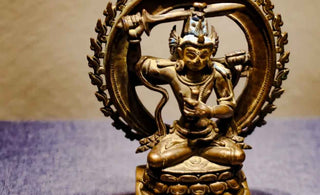
The art of sculpting facial features in Tibetan statues is a profound and intricate process that goes beyond mere craftsmanship. It is an exploration of expression, a sacred dialogue between the artist and the divine represented by the statue. The face, being the window to the soul, becomes a pivotal aspect through which the spiritual essence of the figure is conveyed.
In this intricate artistry, every curve, contour, and expression is meticulously crafted to capture the nuances of the spiritual narrative. The choice of materials, whether it be wood, bronze, or stone, is deliberate, each lending its unique qualities to the facial features. For instance, in a wooden statue, the warm tones and natural grain become integral to portraying a sense of warmth and vitality.
The sculptor embarks on a contemplative journey before beginning the carving process. This meditative state is crucial, as it allows the artist to attune themselves to the spiritual energy they seek to channel. The facial expression of a Tibetan statue is not arbitrary; it is a visual language that communicates the divine qualities associated with the figure—compassion, wisdom, and serenity.
A key element in this process is capturing the eyes, often considered the most expressive part of the face. The eyes of a Buddha statue, for example, are crafted with utmost care, as they are believed to hold the wisdom and compassion of the enlightened being. Whether cast in meditative repose or with a gaze focused on the viewer, the eyes become portals to the spiritual realm.
The nuances of facial expression extend beyond the eyes to include the positioning of eyebrows, the tilt of the head, and the contours of the lips. Each element contributes to the overall mood and energy that the statue emanates. For example, a slight smile on the lips of a Buddha statue may symbolize a compassionate response to the suffering of the world.
The facial features are not static; they evolve with the spiritual narrative being conveyed.
The facial features of Tibetan statues, exemplified by the Sui Dynasty Style Guanyin Head Buddha Statue carved from Grey Limestone, are not static entities but dynamic expressions that evolve in tandem with the spiritual narratives they seek to convey. This particular statue, crafted in the style of the Sui Dynasty, captures the essence of Guanyin, the bodhisattva of compassion. As one gazes upon this masterfully carved visage, the nuances of the facial expression become a visual symphony that tells a story beyond the physical contours.
In the context of this exquisite sculpture, the facial features serve as a conduit for the compassionate energy embodied by Guanyin. The serene gaze and the gentle curvature of the lips are not frozen in a single expression but seem to shift with the changing narratives of compassion that Guanyin represents. In moments of deep contemplation, the eyes may appear more introspective, inviting the observer to join in the bodhisattva's compassionate reflection.
The evolution of facial expression is particularly pronounced in depictions of Guanyin, who is known for her ability to manifest in various forms to aid those in need. In statues like the Sui Dynasty Style Guanyin Head, the facial features might subtly change to convey different facets of compassion—a compassionate smile for solace, a more focused expression for guiding lost souls, or a contemplative look for those seeking inner peace.
The raised eyebrows and finely carved lines on the forehead contribute to the overall mood of the sculpture. When observed closely, these details reveal the artist's skill in capturing the nuanced emotions associated with Guanyin's boundless compassion. The artistry extends to the depiction of the earlobes, elongated as a symbol of spiritual wisdom, and the graceful curve of the neck, signifying flexibility and adaptability in responding to the needs of sentient beings.
The spiritual narrative embodied in the Sui Dynasty Style Guanyin Head extends beyond mere aesthetics. The statue becomes a visual representation of Guanyin's dynamic presence, illustrating her responsiveness to the multifaceted experiences of sentient beings. As viewers engage with the sculpture, they are invited to partake in the evolving story of compassion, finding solace, guidance, and contemplative peace within the intricate details of the facial expression.
The choice of different facial expressions in Tibetan statues mirrors the diversity of spiritual teachings within Buddhism. From the serene countenance of a Bodhisattva to the wrathful intensity of a Dharmapala, each expression serves as a visual guide to understanding different aspects of the path to enlightenment.
It is crucial to acknowledge the cultural and historical context in which these statues are created. The facial features are not only artistic interpretations but also carry the imprints of regional styles, historical influences, and the unique aesthetics of Tibetan art. This diversity adds layers of richness to the expressions, making them a reflection of the complex tapestry of Buddhist culture.
One cannot overlook the spiritual significance of these meticulously sculpted facial features. The act of carving becomes a form of meditation, and the finished statue becomes a conduit for spiritual energy. As observers engage with the statue, they are invited to contemplate the divine qualities embodied in the facial expressions, fostering a connection with the sacred.
Conclusion
In conclusion, the art of sculpting facial features in Tibetan statues is a profound exploration of expression, spirituality, and cultural richness. It is an intricate dance between the artist and the divine, a visual language that communicates the depth of Buddhist teachings. As we delve into the nuances of these meticulously crafted faces, we embark on a journey that transcends mere aesthetics, inviting us to connect with the timeless wisdom encapsulated in the art of Tibetan sculpture.
























